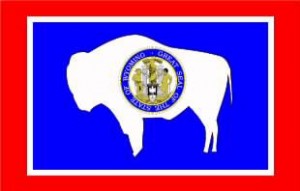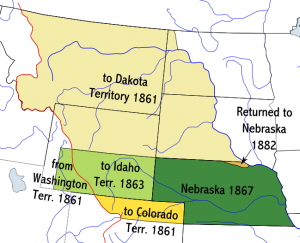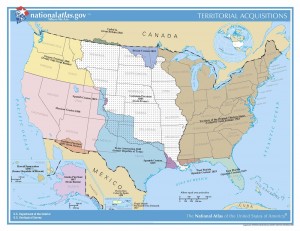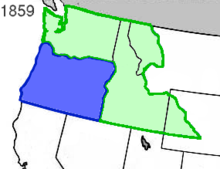Wyoming’s Constitution
So yesterday The Legal Genealogist launched what will be a very lengthy process of working with readers to catalog as many solid sources of American primary law as we can, to put together a resource that will help us all answer a key question we as genealogists often grapple with: what was the law at that time in that place? We’re first going to catalog those documents — charters and constitutions — that frame the structures of government, then go on to statutes and then reported decisions of courts.
 And where better to begin than with one of the most interesting states — located at the far end of the alphabet — with one of the most interesting constitutions, adopted by folks who weren’t yet part of a state when they voted on the document?
And where better to begin than with one of the most interesting states — located at the far end of the alphabet — with one of the most interesting constitutions, adopted by folks who weren’t yet part of a state when they voted on the document?
Officially, it’s the Equality State, because it was the first state where women were given the right to vote1 and where the constitution guaranteed equal rights with men;2 its motto is “Equal Rights.”
Unofficially, it’s the Cowboy State, and its flag, adopted in 1917, depicts the State Seal on a white bison on a field of blue bordered by white and red.3
Wyoming was admitted to the Union 10 July 1890 as the 44th State.4
But from the arrival of Europeans in North America to the adoption of that statute, Wyoming in whole or in part had been owned by Britain, France, Spain, Mexico, and even the Republic of Texas.5 And even after it all came under American ownership, parts of what became Wyoming had been in the Territories of Louisiana, Missouri, Oregon, Washington, Utah, Nebraska, Dakota, and Idaho6 before the Wyoming Territory was created in 1868.In reality, prior to the Louisiana Purchase, which gave the United State control over the bulk of Wyoming’s lands, there wasn’t any need for formal government in what became Wyoming.
The first known explorers didn’t reach the area until 1807, the first organized expedition didn’t cross until 1811, the fur trade didn’t really get started until 1824-25, and the first permanent trading post — at what became Fort Laramie — wasn’t established until 1834.7
 Between the 1803 Louisiana Purchase and the first state constitution, governmental functions for the area east of the Continental Divide were handled by U.S. territorial governors (except for one small area which was part of the Republic of Texas between 1836 and 1846).
Between the 1803 Louisiana Purchase and the first state constitution, governmental functions for the area east of the Continental Divide were handled by U.S. territorial governors (except for one small area which was part of the Republic of Texas between 1836 and 1846).
The governing documents then were the statutes creating various territories and states and moving parts of Wyoming into and out of the territories. The most significant among them were the Louisiana Territory,8 the Missouri Territory, 9 the Nebraska Territory10, the Dakota Territory11
West of the Continental Divide, the land was under British control until the Oregon Treaty of 1846, and then again portions of Wyoming were under territorial governance, with the Oregon Territory12 and later the Washington Territory13 playing the largest roles.The last pre-Statehood territory, of course, was the Wyoming Territory itself.14
In 1888, the Territorial Assembly sent a petition for admission to the Union to the U.S. Congress, where the move to admit Wyoming failed. But Wyoming wouldn’t take no for an answer and proceeded to elect delegates to a constitutional convention, held in Cheyenne in September 1889. The document was submitted to the voters at the November 1889 election and passed by a vote of 6,272 to 1,923.15
The Territory then asked again for Statehood, and this time, it got it, and the 1889 Constitution provided the framework for that first State government formed in 1890. It’s the only Constitution Wyoming has ever had; it was first amended in 191016 and has been amended a total of 70 times.17
In many ways, this whole document is just awesome. It’s one of the longest and most complex constitutions to be found — it has 21 articles and hundreds of sections. It covers more matters than most, including irrigation and water rights, mines and mining, and corporations, in addition to the usual executive, legislative and judicial articles. Because of the detail and scope, it’s a great starting place to determine what the law was at that time in that place.
And it’s got some provisions which, for its time, were just astounding:
• Article 1, Section 3. Since equality in the enjoyment of natural and civil rights is made sure only through political equality, the laws of this state affecting the political rights and privileges of its citizens shall be without distinction of race, color, sex, or any circumstance or condition whatsoever other than individual incompetency, or unworthiness duly ascertained by a court of competent jurisdiction.
• Article 1, Section 7. Absolute, arbitrary power over the lives, liberty and property of freemen exists nowhere in a republic, not even in the largest majority.
• Article 1, Section 15. The penal code shall be framed on the humane principles of reformation and prevention.
• Article 1, Section 30. Perpetuities and monopolies are contrary to the genius of a free state, and shall not be allowed. Corporations being creatures of the state, endowed for the public good with a portion of its sovereign powers, must be subject to its control.
• Article 1, Section 31. Water being essential to industrial prosperity, of limited amount, and easy of diversion from its natural channels, its control must be in the state, which, in providing for its use, shall equally guard all the various interests involved.
None of these sections has changed a single word since the Constitution was adopted in 1889.
A complete copy of the original 1889 constitution appears in Appendix A to Grace Raymond Hebard’s The Government of Wyoming; The History, Constitution and Administration of Affairs.18
A complete copy of today’s Wyoming constitution can be found online at the Wyoming Legislative Service Office (click here).
And a complete copy of the Wyoming Constitution, identifying each and every section that’s been amended and when the amendment took effect, can be downloaded in PDF format from the Office of the Wyoming Secretary of State (click here).
One State’s constitutional documents down… 49 to go.
SOURCES
Territorial images: NationalAtlas.gov; Wikimedia Commons
- “Wyoming’s Equality Heritage,” Facts About Wyoming, Wyoming.gov (http://wyoming.gov : accessed 25 Jun 2012). ↩
- Wyoming Constitution, Article 1, Section 3 (1889), in Grace Raymond Hebard, “Appendix A: Constitution of the State of Wyoming,” The Government of Wyoming; The History, Constitution and Administration of Affairs (San Francisco : Whitaker & Ray, 1904), 199; digital images, Internet Archive (http://www.archive.org : accessed 25 Jun 2012). ↩
- “Wyoming Information,” Wyoming.gov (http://wyoming.gov : accessed 25 Jun 2012). ↩
- See “An act to provide for the admission of the State of Wyoming into the Union, and for other purposes,” 26 Stat. 222 (1890). A PDF of volume 26 of the Statutes at Large is online at Constitution.org. ↩
- Hebard, The Government of Wyoming, 25. ↩
- Ibid., 29. See also Phil Roberts, A New History of Wyoming (http://uwacadweb.uwyo.edu/robertshistory/new_history_of_wyoming.htm : accessed 25 Jun 2012). ↩
- “Chronology — Some Events in Wyoming History,” Wyoming.gov (http://wyoming.gov : accessed 25 Jun 2012). ↩
- “An Act erecting Louisiana into two territories, and providing for the temporary government thereof,” 2 Stat. 283 (1804); digital images, “A Century of Lawmaking for a New Nation: U.S. Congressional Documents and Debates, 1774-1875,” Library of Congress, American Memory (http://memory.loc.gov/ammem/index.html : accessed 25 Jun 2012). See also “An Act further providing for the government of the district of Louisiana,” 2 Stat. 331 (1805). ↩
- “An act providing for the government of the territory of Missouri,” 2 Stat. 743 (1812). ↩
- “An Act to Organize the Territories of Nebraska and Kansas,” 10 Stat. 277 (1854) ↩
- “An Act to provide a temporary Government for the Territory of Dakota,” 12 Stat. 239 (1861). ↩
- “An Act to establigh the Territorial Government of Oregon,” 9 Stat. 323 (1848). ↩
- “An Act to establish the Territorial Government of Washington,” 10 Stat. 172 (1853). ↩
- “An Act to provide a temporary Government for the Territory of Wyoming,” 15 Stat. 178 (1868). ↩
- “Statehood,” Facts About Wyoming, Wyoming.gov (http://wyoming.gov : accessed 25 Jun 2012). ↩
- Article 15, Section 9, Constitution of the State of Wyoming, PDF, 51, published by the Wyoming Secretary of State (soswy.state.wy.us : accessed 25 Jun 2012). ↩
- Roberts, A New History of Wyoming. ↩
- Hebard, “Appendix A: Constitution of the State of Wyoming,” The Government of Wyoming, 199-237. ↩





I love your new series! It matches well with my Heritage Tourism series. I started with Wyoming, as well. Thanks! Added a link to this at:
http://www.squidoo.com/heritage-tourism-in-wyoming
Thanks so much, Bill. We must be kin somewhere if we both start at the back of the alphabet!!